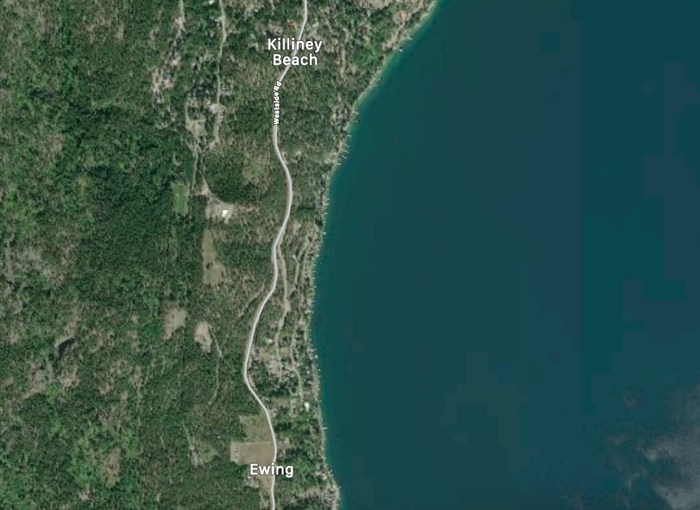
The Killiney Beach and Ewings Landing area on the west side of Okanagan Lake before the White Rock Lake wildfire.
Image Credit: Apple Maps
August 25, 2021 - 6:30 AM
Some residents and media have been able to see first hand the terrible destruction levied by the White Rock Wildfire on communities like Killiney Beach and Estamont.
Seventy-eight homes were destroyed, mostly overnight on Aug. 15-16. But, what’s not been so public is the heroic efforts of firefighters to save hundreds of other homes in the area.
“Once the fire made its way to the lake, multiple, multiple structures were saved in and around the Killiney area, upper and lower, because of the preparations that we all made,” Alex Van Bruksvoort, chief of North Westside Fire Rescue, told iNFOnews.ca.
“I’m incredibly blessed to have brothers and sisters of multiple departments (who came to help),” he said, noting people gave up their days off and vacation time to come from fire departments in Lake Country, Ellison, Peachland, Wilsons Landing and others to help.
“I call my firefighters community eagles,” Van Bruksvoort said. “We soared that night. Anything that could be and would be saved, was saved to the point I know of personally, firefighters going into homes that were going to be lost and they grabbed personal items, pictures and valuables and put them into pillow cases.”
The North Westside fire boat was parked in Okanagan Lake to lift water to supply trucks and storage containers further up the hill.
Initial reports from fire officials said the boat was pulled away on several occasions to rescue people from docks.
READ MORE: The real cost of refusing to evacuate the White Rock Lake wildfire in the Okanagan
Since then, some Killiney Beach residents have contacted iNFOnews.ca to say that no one was rescued.
Last week, Van Bruksvoort would not talk about what happened that night (Aug. 15-16) but he was willing to clarify the situation as he understands it.
While, initially, the boat was pumping water up the hill, that changed as the wind shifted and the fire roared down towards Okanagan Lake.
“I stopped the water because the fire was coming straight down in that area and we had structures (on fire),” Van Bruksvoort said. “Our mandate is, our boat is for structural protection. I gave that to my captain on the boat because we were losing structures. I don’t know how long we were fighting and saving structures and losing structures down there. Then we found people calling out to us wanting to be rescued off of docks.”
The boat did pick those people up but continued to fight the fire at the same time.
“We would not have stopped fighting purposely,” Van Bruksvoort said. “Any time you would have done that, you would be covering yourself anyways with a water stream.”
By that time there were bladders (containers like SeaCans full of water) and “pumpkins” (like swimming pools filled with 1,500 to 2,000 gallons of water) for firefighters to access upland. There was as much as 50,000 litres of water available to firefighters, he said.
While Central Okanagan Regional District director Wayne Carson speculated that trucks had to drive all the way to West Kelowna when the fire boat was called away, Van Bruksvoort stressed that was not the case.
READ MORE: Bulk of wildfire destruction on Okanagan Lake's west side in Estamont: regional district director
Insead, there were a number of other pumps set up in Okanagan Lake at strategic points along Westside Road for tankers to fill up from.
Another resident raised concerns about the water supply being cut off to fire hydrants because the electrical supply was cut.
“We had an endless amount of tankers and trucks," Van Bruksvoort said. “We wouldn’t be hooking up to hydrants. We would not be fighting a wildfire like that.”
Besides, he said, unprotected generators would be at risk of being destroyed by the fire in that situation.
What people who have not been in the midst of a wildfire cannot understand is the magnitude of such a blaze, he said.
“When a fire is moving at 60-70 kilometres an hour and it’s thousands of degrees hot and it’s moving through, there’s nothing that one can do to stop that,” Van Bruksvoort said. “B.C. Wildfire's and all my crews and all the other agencies, did absolutely everything to harden homes, to FireSmart the area. I can guarantee you that everything that could possibly be saved in this fire was done.”
Then there’s the toll it takes on the firefighters themselves, many of whom live in the community.
“These firefighters are heroes,” he said. “My firefighters are broken right now because these are their friends, their families. But, they continue to fight. They continue to go on patrols every night. We still have spot fires. We’re still in a live fire zone with a fire that’s still out of control. So many people don’t see that. They don’t understand that.”
To contact a reporter for this story, email Rob Munro or call 250-808-0143 or email the editor. You can also submit photos, videos or news tips to the newsroom and be entered to win a monthly prize draw.
We welcome your comments and opinions on our stories but play nice. We won't censor or delete comments unless they contain off-topic statements or links, unnecessary vulgarity, false facts, spam or obviously fake profiles. If you have any concerns about what you see in comments, email the editor in the link above.
News from © iNFOnews, 2021